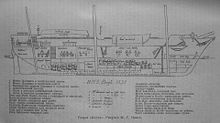Cherokee-class brig-sloop

Longitudinal section of HMS Beagle (Cherokee class) as of 1832, by then converted to a barque by addition of a mizzen-mast.
|
|
| Class overview | |
|---|---|
| Name: | Cherokee-class brig-sloop |
| Operators: |
|
| Planned: | 115 |
| Completed: |
|
| Cancelled: | 11 |
| General characteristics | |
| Type: | Brig-sloop |
| Tons burthen: | 237 bm in Cherokee |
| Length: |
|
| Beam: | 24 ft 6 in (7.47 m) |
| Draught: | 12 ft 6 in (3.81 m) |
| Depth of hold: | 11 ft 0 in (3.35 m) |
| Propulsion: | Sails |
| Complement: |
|
| Armament: |
|
The Cherokee class was a class of brig-sloops of the Royal Navy, mounting 10 guns. Brig-sloops are sloops-of-war with two masts (a fore mast and a taller main mast) rather than the three masts of ship sloops. Orders for 115 vessels were placed, including 5 which were cancelled and 6 for which the orders were replaced by ones for equivalent steam-powered paddle vessels.
Many of these sailing vessels served as mail packet ships, and more than eight assisted with exploration and surveys. The best known of the class was HMS Beagle, converted in 1825 into a three-masted barque as an exploration and survey vessel before its first voyage, then considerably modified for the second survey voyage under Robert FitzRoy, with the gentleman naturalist Charles Darwin on board as a self-funded .
The carronade, nicknamed the "smasher" or "devil gun", was significantly smaller and lighter than conventional cannon. It was also found to have a more destructive broadside at close range, so that a smaller (and cheaper) ship could be more effective in naval actions than a much larger man-of-war. Sir Henry Peake designed a small ship to operate in both shallow and deep waters, carrying eight 16-pounder or 18-pounder carronades plus two long 6-pounder cannon as forward-mounted chase guns.
The design for the Cherokee class was completed in 1807 by Henry Peake and approved on 26 November 1807, with the first four vessels having been ordered in March 1807 but not laid down until December; by the end of 1808 another 30 vessels had been ordered to this design. After these 34, a further 2 were ordered in 1812 which were built of teak at Bombay. The design was revived after the end of the Napoleonic Wars, and another 78 were ordered in two batches between 1817 and 1827. The first batch of these later vessels consisted of 35 orders (of which one was cancelled) whilst the second amounted to 44 new vessels of which 4 were cancelled and 6 replaced by orders for paddle vessels.
...
Wikipedia
